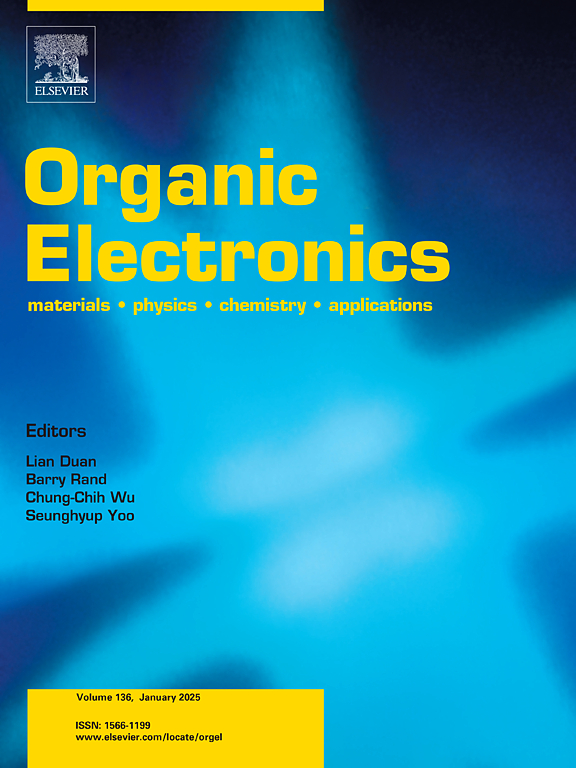Thermally activated delayed fluorescence host materials with bulky indolocarbazole derivatives acceptors for high-performance solution-processed OLEDs
IF 2.7
4区 工程技术
Q3 MATERIALS SCIENCE, MULTIDISCIPLINARY
引用次数: 0
Abstract
The design and development of large steric-hindrance host materials can effectively solve the quenching of triplet excitons, so as to improve the utilization of excitons and the performance of organic light-emitting diodes (OLED) devices. In this work, four large volume thermally activated delayed fluorescence (TADF) host materials were synthesized using triazine derivatives as electron acceptors and indolocarbazole derivatives as electron donors. Systematic studies demonstrated that introducing tert-butyl carbazole into indolocarbazole derivatives not only increased the steric hindrance of the molecule but also improved its thermodynamic stability. The decomposition temperatures (Td) of TRZ-tCzICz and MeTRZ-tCzICz reached 449 °C and 481 °C, and there was no significant glassing transition temperature (Tg) in the range of 20–200 °C. The strategy of introducing methyl into triazine effectively separated HOMO and LUMO of molecule, resulting in smaller singlet-triplet splitting (ΔEST) and larger reverse intersystem crossing rates (kRISC). Among the four molecules, the kRISC of TRZ-tCzICz and MeTRZ-tCzICz reached 2.07 × 106 s−1 and 2.16 × 106 s−1, respectively. All four synthesized molecules had relatively high triplet energy levels and can serve as host materials for green TADF compounds. With 4CzIPN as the dopant, the solution processable OLED devices based the four compounds as the host materials achieved maximum external quantum efficiency (EQEmax) of 11.13 %.

具有大体积吲哚咔唑衍生物受体的热激活延迟荧光主体材料用于高性能溶液处理oled
设计和开发大空间位阻主体材料可以有效解决三重态激子的猝灭问题,从而提高激子的利用率和有机发光二极管(OLED)器件的性能。本文以三嗪衍生物为电子受体,吲哚咔唑衍生物为电子给体,合成了四种大体积热激活延迟荧光(TADF)宿主材料。系统研究表明,在吲哚咔唑衍生物中引入叔丁基咔唑,不仅增加了分子的位阻,而且提高了分子的热力学稳定性。TRZ-tCzICz和MeTRZ-tCzICz的分解温度(Td)分别达到449℃和481℃,在20 ~ 200℃范围内没有明显的玻璃化转变温度(Tg)。在三嗪中引入甲基的策略有效地分离了分子的HOMO和LUMO,从而减小了单重态-三重态分裂(ΔEST)和较大的逆向系统间交叉速率(kRISC)。其中TRZ-tCzICz和MeTRZ-tCzICz的kRISC分别达到2.07 × 106 s−1和2.16 × 106 s−1。这四种合成的分子都具有较高的三重态能级,可以作为绿色TADF化合物的宿主材料。以4CzIPN为掺杂剂,基于这四种化合物为主体材料的溶液可加工OLED器件的最大外量子效率(EQEmax)为11.13%。
本文章由计算机程序翻译,如有差异,请以英文原文为准。
求助全文
约1分钟内获得全文
求助全文
来源期刊

Organic Electronics
工程技术-材料科学:综合
CiteScore
6.60
自引率
6.20%
发文量
238
审稿时长
44 days
期刊介绍:
Organic Electronics is a journal whose primary interdisciplinary focus is on materials and phenomena related to organic devices such as light emitting diodes, thin film transistors, photovoltaic cells, sensors, memories, etc.
Papers suitable for publication in this journal cover such topics as photoconductive and electronic properties of organic materials, thin film structures and characterization in the context of organic devices, charge and exciton transport, organic electronic and optoelectronic devices.
 求助内容:
求助内容: 应助结果提醒方式:
应助结果提醒方式:


